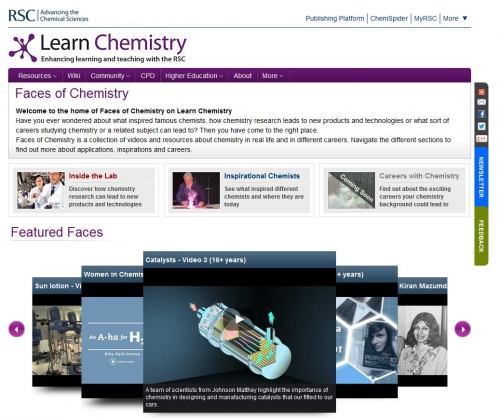Faces of Chemistry – like so many things, our popular video series started with an idea! We wanted to show students of all ages how chemistry applies to real life and how the latest cutting-edge research leads to many different new products and technologies.
It’s been almost two years since we launched our first videos. Since then you might have heard Meloney Morris from Syngenta explain how chemistry helps to protect crops, watched scientists from Procter & Gamble tell you about why they love developing new hair colourants or found out more about organic solar cells from BASF’s Ingmar Bruder.
We’ve loved making these videos and hope that you’ve enjoyed watching them just as much. But at the same time we thought that Faces of Chemistry could be so much more than this. We wanted it to represent all sorts of people doing all sorts of things with chemistry, not just those working in industry or academia.
So Faces of Chemistry has undergone a mini revolution.
And to mark the occasion, we’ve built a brand
new microsite. It’s now mobile- and tablet-friendly, meaning you can easily flick through our features ‘faces’ on mobile phones, iPads, etc. whilst you’re on the go.

But we’ve not just made it easier to browse the videos. We’ve also added two new sections: ‘Inspirational chemists’ and ‘Careers with chemistry’ (coming soon) join the existing ‘Inside the lab’ videos. So in addition to leaning more about the chemistry found in many products and items that we use every day, you can now also find out what inspired others to become chemists and how diverse the career options with a background in chemistry can be.
When you visit our new
Faces of Chemistry site, you will hopefully notice that it is a lot easier to find and play the videos you’re looking for. The Inside the Lab section, pictured below, is divided into three tabs for the different age groups. You’ll also be able to click the ‘view resource’ link below the videos to see all the Faces of Chemistry videos we have on that specific topic.

We’d love to hear what you think about Faces of Chemistry’s new look. So please do get in touch. And if you have any suggestions about what you’d like to see here, then feel free to let us know. We are always looking for your feedback (good or bad) to help shape our future developments.
Enjoy using the new Faces of Chemistry site, and keep your eyes peeled for the new Careers with Chemistry section coming soon!
